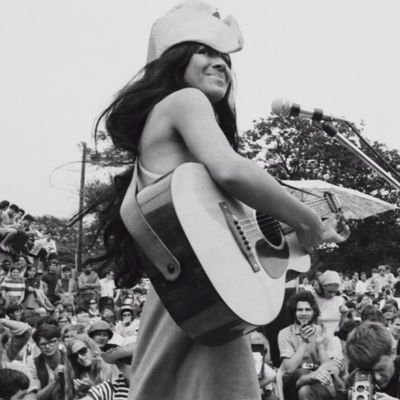
In 1988, Stevie Salas was only three years removed from gigging around the San Diego area with his high-school band, This Kids, when he realized his rock-and-roll fantasy. At 23, he joined his next band, playing guitar on the biggest of stages behind Rod Stewart. The Out of Order Tour was 142 sold-out nights across North and South America, a full baptism by Bic lighter for the young ax-ripping prodigy. It was what everyone who ever dreamed of rock stardom would want, but along the way, Salas had a revelation that went beyond the moment, with a question that would become as important to his musical evolution as his own capabilities.
“It was crazy, the bass player, Carmine Rojas, was David Bowie’s bass player, and I had his picture on my wall growing up, and I’m sitting next to him on a private jet,” Salas, 56, says, laughing at the absurdity. “We were in the middle of a three-night run in Manhattan, and while onstage, I wondered to myself, Am I the only Native person to ever play Madison Square Garden?”
As he would soon find out, the answer was no. There had been plenty of Native artists, including virtuoso guitarist Jesse Ed Davis, a Comanche and Kiowa Indian from Oklahoma, who played George Harrison’s legendary Concert for Bangladesh, jamming alongside the former Beatle and Eric Clapton on “While My Guitar Gently Weeps.” Davis also preceded Salas in other massive venues as a guitarist on the final Faces tour, fronted by Rod Stewart. It bugged Salas that he was unaware of the indigenous connections in his own time.
“I started doing research and realized I was playing Jesse Ed Davis’s guitar parts, I thought I knew all about him from reading the liner notes, but I had no idea he was Native American,” says Salas, an Apache Indian. “I had to get educated and figure out a way to get the information out there. Native Americans often feel like the only role models are from a hundred years ago, but here you have amazing musicians who influenced the greatest rock stars in history and nobody knows about them.”
The ultimate outgrowth of Salas’s work is Rumble: The Indians Who Rocked the World, a documentary streaming for free on PBS’s Independent Lens website through February 4. It’s a terrific look at a range of Native musicians, from the iconic Jimi Hendrix whose feathers, vests, boas, fringe, and suede came from his Cherokee grandmother Nora’s costume trunk, to the celebrated speakeasy jazz singer Mildred Bailey (Tony Bennett reveals that he exclusively did her songs as a young singing waiter), to Randy Castillo, Ozzy Osbourne’s wicked Isleta Pueblo/Apache drummer who brought the syncopation of the powwow to the world of heavy metal.
The documentary is meant to give viewers a sense of indigenous musicians’ roles in popular music history, the influences that have been whitewashed out of existence. Rumble takes its name from the Link Wray song of the same name, the incredible seductive 1958 fuzzy guitar stroll that Steven Van Zandt refers to as “the theme song of juvenile delinquency” in the film. It doesn’t get any more whitewashed than banning the song of a Shawnee Indian for fear of teenage violence. Worth noting, it’s an instrumental.
“The oppression and attempted termination of Native Americans was systematic and an organized effort. The film is truly a breakthrough and much needed to help educate the public of the contributions of Native musicians,” says Kalapuya Indian Jan Michael Looking Wolf, an author, professor, and an award-winning flutist.
Rumble is an antidote to the lack of visibility and respect of indigenous peoples in everyday American discourse, which is how a Native elder playing a drum ends up being “tomahawk chopped” in the same city where the football team is an ethnic slur. Rumble isn’t heavy on traditional music, but it uses history to draw a straight line of the art that emerged over centuries of pain and suffering. From colonial enslavement (poet and scholar John Sinclair notes that southern Indians used to pass as African-Americans because slaves got better treatment than those shunted to reservations) through Wounded Knee when, in 1890, 300 Sioux Indians, mostly women and children, were slaughtered (in part as a U.S. Army response to the spiritual movement known as the Ghost Dance), and on to Standing Rock and the Indigenous Peoples Marches of the 21st century. Blues, country, jazz, folk, rock, “The Ballad of Ira Hayes,” it’s all in there.
For all of the horrific genocidal realities underpinning the chapters in Rumble, Salas and co-directors Catherine Bainbridge and Alfonso Maiorana knew they wanted the movie to be a lot of fun. The individual sections are mash notes from a wide range of musicians in Salas’s orbit, including Taj Mahal, Iggy Pop, Slash, Cyril Neville, and Jackson Browne, who tells a great story about Jesse Ed Davis crushing the guitar solo on “Doctor My Eyes” in one take without even listening to the song all the way through.
The familiarity is what stands out in Rumble, shining a light on the Native contributions to the collective soundtrack of our musical lives. Cultural representation is hugely important. It was for Stevie Salas at Madison Square Garden, and it will be for some Native kid who just picked up a guitar.
“My hope is anyone who feels repressed due to the color of their skin can see the film and know anything is possible,” says Salas, who is heading out in February with the Starman alumni-laden David Bowie Celebration Tour. “I’m a surfer, and every year growing up, I would watch The Endless Summer, a bitchin’ documentary. My dream for Rumble is the same thing, kids and musicians watching it again and again long after I’m gone.”




